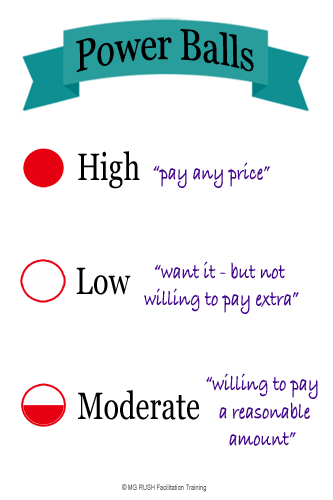Strongly encouraged by Steve Jobs, as mentioned in his biography by Walter Isaacson, here is how to facilitate reducing some possible actions a team should consider, down to the final three or four actions your team has the resources to complete.
As mentioned casually in the biography, the concept of prioritization is key to group performance, so we will remind you about three remarkably effective and frequently used facilitation techniques from the MGRUSH method; namely Definition, PowerBalls (aka MoSCoW), and BookEnds. First, before you distill your final list of ten or twelve action items, be prepared to define the full meaning behind the terms first used. Additionally, stay conscious of the team’s perspective and possible biases.
Bias Factors that Demonstrably Affect Group Decision-Making
Everyone poorly estimates the time they need to complete any task. Fallacies and biases put us all at increasing risk of reaching our objectives. Therefore, psychologists call it the planning fallacy and the bias of overconfidence. According to the World Future Society, other significant factors known to negatively impact decision quality include:
- Confusing desirability and familiarity with probability
- Distorting data through selection and repetition
- Forecasting with a preference for change or patterns
- Framing complex issues in a skewed fashion (selective perception)
- Homogenizing multiple data sources (for cost savings)
- Lacking clear confidence intervals (how clean the data is)
- Mistaking correlation for causation (a quite common error)
- Over-immersion in local social values or perceptions
Facilitate Prioritization by Starting with the End in Mind
Are you helping the team define a final output, a desired outcome, or are you having them focus clearly on the next step (that presumably leads to a final output AND a new, desired outcome) or action required?
- Describe the objectives with enough clarity that everyone provides their commitment.
- Next, use our PowerBall tool to build consensus in minutes, not hours. (Known in the Agile world as MoSCoW, see below).
Definition Tool
If you are challenged about the scope, characteristics, or details of some proposed action, consider using the Definition tool. Hence, in its most robust format, a thorough definition answers five discrete questions (See the Definition tool for an example):
- What is the action NOT?
- Describe the action in one sentence or less than 50 words.
- Provide the specific characteristics that make this action clear or unique.
- Draw or illustrate the action or workflow.
- Provide at least two examples from the business to vivify or bring to life the narrative definition.
Once you have a list of ten or so clear and potential actions the team has socialized and understood, then apply the PowerBalls tool (MoSCoW).
Rationale to Facilitate Prioritization
It’s faster to get a group to agree on what NOT to discuss anymore. Therefore, apply the Pareto Principle (aka 80-20 Rule) to help a group eliminate as many options as possible. By deselecting first, the group can stay focused, build traction, and you can facilitate prioritization around the most important or attractive options.
CAUTION When You Facilitate Prioritization
Be aware that an optimal approach requires to prioritize the criteria, not the options. Therefore, if you find yourself prioritizing options, reverse-engineer them by asking WHY. Then by simply asking, the responses generate the criteria or rationale used for the prioritization. (Also, know that you need to have an agreed-upon purpose to facilitate prioritization and resolve arguments.)
Method to Facilitate Prioritization
The following steps should be read with an understanding that the ‘hot linked’ activities and procedures used below to facilitate prioritization are explained more fully elsewhere on this site on “Facilitation Best Practices” and found in the MG RUSH curriculum. You will discover that PowerBall measurements provide flexible instruments for measuring anything. Consequently, for simple decision-making, use the following steps:
- Establish the purpose of the object the team is considering (i.e., Purpose of _______ is to . . . So that . . .). Hence, you have now established WHY this action is important.
- Build your list of options (e.g., Brainstorming). Additionally, strive for creativity and innovation by encouraging more, even wild ideas. Set the list of options aside.
- Build your list of decision criteria (be prepared to define each “criterion”).
- Look at the criteria to see if any options are in direct violation. For example, if Sally is allergic to flowers, then “buying her flowers” presents an option that should be eliminated. However, using SCAMPER we might discover other options such as silk flowers, a painting of flowers, etc.
- Ask the participants if they can support the remaining options. If someone objects, consider eliminating that option if numerous others are satisfactory to everyone.
- Once your participants can support the remaining options, you have consensus, however, you don’t yet have your deliverable.
- To improve the quality of your decision, unveil the visual legend for PowerBalls. Finally, always use the economic definitions shown.
NOTE:
The terms in black will change. They could be full, empty, half-full. They could be frequent, rarely, occasionally. However, the economic definitions always work. You may also find the tool called something else such as Harvey Balls, MoSCoW, etc.
NEXT . . .
- Apply the PowerBalls and prioritize the criteria, using the Book-End rhetoric, explained fully below. Here we ask, “Which is most?”, “Which is least?”, etc., and squeeze in on the moderate stuff.
- Find the option(s) that best aligns with and supports your stated purpose (Step 1). Therefore, appealing to the previously built purpose statement confirms the most appropriate or impactful criteria.
Apply Bookends Rhetoric to Avoid Wasting Time with Lists
Effective facilitators shy away from analyzing lists linearly. The purpose of using our Bookends Method is to develop a natural habit of squeezing the grey matter towards the middle, rather than wasting too much time on it.
The Rationale of Bookends
Groups tend to argue about a grey matter that frequently does not affect the decision anyway. For instance, with PowerBalls, you can envision some participants arguing whether something is more important than moderate yet less important than high. We know from experience that high criteria drive most decisions, so bookends help us identify the most important stuff quickly.
The Bookend Rhetoric
After you have compiled a list, compare and contrast different items with the straightforward process as explained below:
- Ask, “Which of these is the most important?” (as defined by the PowerBalls displayed).
- Next ask, “Which of these is the least important?”
- Then return to the next most important
- And to the next least important
Until the list has been squeezed into the remaining one-third that is moderate.
If comparing or contrasting illustrations, consider asking…
- Which is most similar?
- Which is least similar?
Repeat until one-third remains as moderate.
For discussions consider asking . . .
- What is your greatest strength?
- What is your greatest weakness?
Repeat until one-third remains as moderate.
Definitions to Facilitate Prioritization
The definitions provided in the iconic legend above apply to all situations and can be equated or converted to numbers, such as:
- 5 or a solid ball means high “Pay any price.”
- 1 or an empty circle means low or “Want it for free, not willing to pay extra for it.”
- 3 or a half-filled ball means moderate or all the other stuff between high and low, meaning we are “willing to pay a reasonable price” without being forced to define “reasonable.”
Five-Level Numeric Alternative (plus Null) Where More is Better
- Low Importance
- Moderately Low Importance (if necessary)
- Moderate Importance
- Moderately High Importance (if necessary)
- High Importance
Ø. NULL or Will NOT have
MoSCoW Alternative
Alternatively, in the Agile world, PowerBalls also equate to MoSCoW, whereby:
- M equals Must have and equates to a solid ball, or the number 5
- S equals Should have and equates to a half-filled ball, or the number 3
- C equals Could have and equates to an empty circle, or the number 1
- W equates to Won’t have or the null (the ‘o’ makes the mnemonic easier to remember)
With MoSCoW or PowerBalls, separate the most/ least important criteria, force-fitting one-third high and one-third low. Cluster the remaining one-third and code them as moderate by default, without discussion. Attempt to force fit one-third of the candidates as each high, low, and moderate—but be flexible. Appeal to the high criteria and isolate the option(s) that best support the purpose statement. Additionally, to advance understanding further or to optimize or guide discussion (if required), appeal to some of the fuzzy factors that may be difficult to measure objectively.
When you need help creating a robust definition of an option or a criterion that may be arguable, turn to the Definition Tool for support. If you discover the PowerBall technique is not robust enough, use something more suitable for complicated prioritization such as the MGRUSH Scorecard tool or Perceptual Mapping.
______
Don’t ruin your career by hosting bad meetings. Sign up for a workshop or send this to someone who should. MGRUSH workshops focus on meeting design and practice. Each person practices tools, methods, and activities daily during the week. Therefore, while some call this immersion, we call it the road to building high-value facilitation skills.
Our workshops also provide a superb way to earn up to 40 SEUs from the Scrum Alliance, 40 CDUs from IIBA, 40 Continuous Learning Points (CLPs) based on Federal Acquisition Certification Continuous Professional Learning Requirements using Training and Education activities, 40 Professional Development Units (PDUs) from SAVE International, as well as 4.0 CEUs for other professions. (See workshop and Reference Manual descriptions for details.)
Want a free 10-minute break timer? Sign up for our once-monthly newsletter HERE and receive a free timer along with four other of our favorite facilitation tools.
Related video

Terrence Metz, president of MG RUSH Facilitation Training, was just 22-years-old and working as a Sales Engineer at Honeywell when he recognized a widespread problem—most meetings were ineffective and poorly led, wasting both time and company resources. However, he also observed meetings that worked. What set them apart? A well-prepared leader who structured the session to ensure participants contributed meaningfully and achieved clear outcomes.
Throughout his career, Metz, who earned an MBA from Kellogg (Northwestern University) experienced and also trained in various facilitation techniques. In 2004, he purchased MG RUSH where he shifted his focus toward improving established meeting designs and building a curriculum that would teach others how to lead, facilitate, and structure meetings that drive results. His expertise in training world-class facilitators led to the 2020 publication of Meetings That Get Results: A Guide to Building Better Meetings, a comprehensive resource on effectively building consensus.
Grounded in the principle that “nobody is smarter than everybody,” the book details the why, what, and how of building consensus when making decisions, planning, and solving problems. Along with a Participant’s Guide and supplemental workshops, it supports learning from foundational awareness to professional certification.
Metz’s first book, Change or Die: A Business Process Improvement Manual, tackled the challenges of process optimization. His upcoming book, Catalyst: Facilitating Innovation, focuses on meetings and workshops that don’t simply end when time runs out but conclude with actionable next steps and clear assignments—ensuring progress beyond discussions and ideas.





